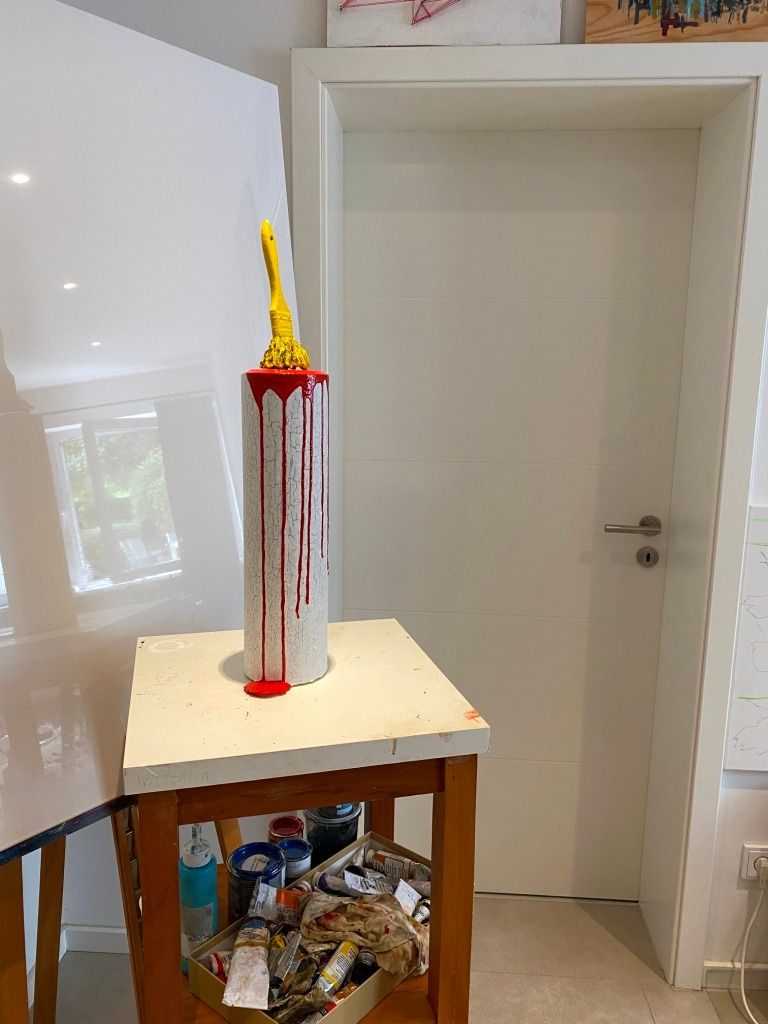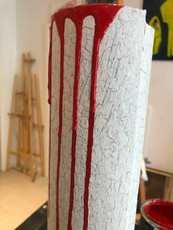
brush, stone, colour, varnishes, 59H x 12L x 14W cm.
The finished painting, initially a canvas, hangs on the wall or is exhibited in the gallery, at the same the brush after completing the painting ends up in the trash can. But what if not? This work is an imagination of a Monument to a labour brush.
I choose the vibrant colours of pop culture. The used brush is shown simply and playfully, where an artist used a brush with one colour to create something new, so to say different colour. At the same time, it should be fun and understandable for most people. Such a composition encourages everyone to take a brush and start painting.
The work on this sculpture took a long time.
First came the idea of the bases for the sculpture. In the previous part of the course, it was not clear to me what options exist to support sculptures, and I began to experiment. I found ready-made stone blocks for garden paths or fences at a nearby store. It seemed to me that a separate piece of stone itself already looks like part of the sculptural composition and the material itself can be successfully combined with other surfaces and materials.

Second, at that time I realised that tactile senses at the time of quarantine and in general in "the digital world" is different from "the normal world" or not exist. So I decided to experiment with one of the stone blocks which I bought.

My idea was to change the texture of the stone from rough to smooth. At the same time, the weight of the stand itself will remain, which will be interesting from the point of view of contradictions in the material and its changes, soft, but small and heavy. I didn't want to cover the base with paint, but I just wanted to focus on the sensations. And anyway I already imagined the sensations of all the paints I have, and it was either smooth glossy feelings or matte-rough. The feeling I wanted to achieve was wax. Smooth-velvety. Wax is usually added to hand cream, so I decided to heat the wax onto the stone and smooth it over. The result is a soft-touch coating on the cold stone. An incredibly interesting feeling, but a terrible look. It was as if the stone was covered with rubella.
In parallel with this process, I had to paint the newly built wooden deck. (If there is one artist in the family, then it looks like she is obliged to paint terraces, walls and paintings.) In the process, I thought of such a versatile job for just one brush. It can be both a tool for creating art and just be a good helper. And I wanted to thank it. After work, the brush was so shabby and tired - like a hero, whose merits are taken for granted. At that moment the full concept came. The used brush should be not in a rubbish bin but on the pedestal.
And then, it seems to me, I left the original idea aside as I began to compose further. The original brush colour was brownish and ugly so it needed to be changed. A couple of tries and I focused on pop art colours - bright red and yellow. They confront each other. The brush would be one colour, but a different colour would drop off. Then the game of metaphors pulled me in. A brush can paint one thing, but it will indicate another. That is, here the paint itself and the colour interpret the interaction of the brush and paint. One uses the other, but something third is obtained.

My aesthetic world did not allow me to continue the process with this “not pretty” cover, so I began to over paint it. Due to a mistake in the choice of paint, a crackle effect was obtained. Simple spilling paint turned out to be a tricky process, it flowed in all directions and not as it should. Then the paint was not expressive enough and did not create volume, it had to be repainted several times.
In the end, although the result was different from what was planned, the essence did not finally change but was supplemented. This is a monument to a labour brush that changes the colour (context) of the final piece.














Comments